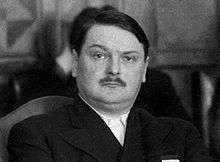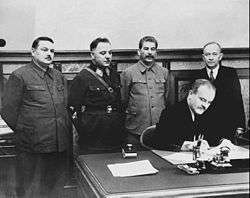Andrei Zhdanov
| Andrei Zhdanov Андре́й Жда́нов | |
|---|---|
 | |
| Chairman of the Soviet of the Union | |
|
In office 12 March 1946 – 25 February 1947 | |
| Preceded by | Andrey Andreyev |
| Succeeded by | Ivan Parfenov |
| Chairman of the Supreme Soviet of the Russian SFSR | |
|
In office 15 July 1938 – 19 July 1938 | |
| Preceded by | Mikhail Kalinin |
| Succeeded by | Mikhail Tarasov |
| Head of the Propaganda and Agitation Department of the Central Committee | |
|
In office 21 March 1939 – 6 September 1940 | |
| Preceded by | Post established |
| Succeeded by | Georgy Aleksandrov |
| Full member of the 18th Politburo | |
|
In office 22 March 1939 – 31 August 1948 | |
| Candidate member of the 17th Politburo | |
|
In office 10 February 1934 – 22 March 1939 | |
| Member of the 17th, 18th Secretariat | |
|
In office 10 February 1934 – 31 August 1948 | |
| Member of the 17th, 18th Orgburo | |
|
In office 10 February 1934 – 31 August 1948 | |
| Personal details | |
| Born |
Andrei Alexandrovich Zhdanov 26 February 1896 Mariupol, Russian Empire |
| Died |
31 August 1948 (aged 52) Moscow, Russian SFSR, Soviet Union |
| Citizenship | Soviet |
| Nationality | Russian |
| Political party | All-Union Communist Party (bolsheviks) |
| Occupation | Civil servant |
Andrei Alexandrovich Zhdanov (Russian: Андре́й Алекса́ндрович Жда́нов; IPA: [ɐnˈdrej ɐlʲɪˈksandrəvʲɪtɕˈʐdanəf]; 26 February [O.S. 14 February] 1896 – 31 August 1948) was a Soviet politician. After World War II, he was thought to be the successor-in-waiting to Joseph Stalin, but Zhdanov died before Stalin.
Career

Zhdanov enlisted with the Russian Social Democratic Labour Party (Bolshevik) in 1915 and was promoted through the party ranks, becoming the All-Union Communist Party manager in Leningrad after the assassination of Sergei Kirov in 1934. He was Chairman of the RSFSR Supreme Soviet from 20 July 1938–20 June 1947. Though somewhat less active than Vyacheslav Molotov, Joseph Stalin, Lazar Kaganovich and Kliment Voroshilov, Zhdanov was a major perpetrator of the Great Terror and personally approved 176 documented execution lists.[1] In June 1940, he was sent to Estonia[2] to supervise the establishment of the Estonian Soviet Socialist Republic and its annexation by the USSR.
Zhdanov took a leading role during the Siege of Leningrad during World War II. After the cease-fire agreement between Finland and the USSR was signed in Moscow on 4 September 1944, Zhdanov directed the Allied Control Commission in Finland until the Paris peace treaty of 1947.
Zhdanov was appointed by Joseph Stalin to direct the Soviet Union's cultural policy in 1946. His first action (in December 1946) was to censor Russian writers such as Anna Akhmatova and Mikhail Zoshchenko. He formulated what became known as the Zhdanov Doctrine ("The only conflict that is possible in Soviet culture is the conflict between good and best"). During 1946–1947, Zhdanov was Chairman of the Soviet of the Union. In 1947, he organized the Cominform, designed to coordinate and control the communist parties around the world. In February 1948, he initiated purges among musicians, widely known as a struggle against formalism. Dmitri Shostakovich, Sergei Prokofiev, Aram Khachaturian and many other composers were reprimanded during this period. In June 1948, Stalin sent Zhdanov to the Cominform meeting in Bucharest. The purpose of the meeting was to condemn Yugoslavia, but Zhdanov took a more restrained line, in contrast to his co-delegate and rival Georgy Malenkov. This infuriated Stalin, who removed Zhdanov from all his posts and replaced him with Malenkov. Zhdanov was transferred to a sanatorium, where he died. It is possible that his death was the result of an intentional misdiagnosis.[3]
Zhdanov died on 31 August 1948 in Moscow of heart failure; Nikita Khrushchev recalled in Khrushchev Remembers that Zhdanov was an alcoholic, and that during his "last days," Stalin would shout at him to stop drinking and insist that he drink only fruit juice.[4] Stalin had talked of Zhdanov being his successor but Zhdanov's ill health gave his rivals, Lavrentiy Beria and Georgy Malenkov, an opportunity to undermine him.
He was one of those accused during the U.S. House of Representatives' Kersten Committee investigation into the annexation of the Baltic States in 1953.[5]
Ideology
Originating in 1946 and lasting until the late 1950s, Zhdanov's ideological code, known as the Zhdanov doctrine, Zhdanovism or zhdanovshchina, defined cultural production in the Soviet Union. Zhdanov intended to create a new philosophy of artistic creation valid for the entire world. His method reduced all of culture to a sort of chart, wherein a given symbol corresponded to a simple moral value. Zhdanov and his associates further sought to eliminate foreign influence from Soviet art, proclaiming that "incorrect art" was an ideological diversion.[6] This doctrine suggested that the world was split into two opposing camps, namely, the “imperialistic”-led by the United States and the “democratic”-led by the Soviet Union, using Cold War terminology that also began in 1946. The one sentence that came to define Zhdanovshchina was “The only conflict that is possible in Soviet culture is the conflict between good and best". This cultural policy became strictly enforced, censoring writers, artists, and the intelligentsia, with punishment being applied for failing to conform to what was considered acceptable by Zhdanov’s standards. This policy officially ended in 1952, seen as having a negative impact on culture within the USSR. The origins of this policy can be seen before 1946 when critics proposed (wrongly according to Zhdanov) that Russian classics had been influenced by famous foreign writers, but the policy came into effect specifically to target “apolitical, ‘bourgeois’, individualistic works of the satirist Mikhail Zoshchenko and the poet Anna Akhmatova”, respectively writing for the literary magazines Zvezda and Leningrad. On 20 February 1948, Zhdanovshchina shifted its focus towards anti-formalism, targeting composers such as Dmitri Shostakovich. That April, many of the persecuted composers were pressed into repenting for displaying “formalism” in their music in a special congress of the Union of Soviet Composers. These composers were not rehabilitated by the Soviet Union until 28 May 1958.
Family ties
Zhdanov's son, Yuri (1919–2006), married Stalin's daughter, Svetlana Alliluyeva, in 1949. That marriage ended in divorce in 1950. They had one daughter, Yekaterina.
Honours and awards
- Two Orders of Lenin
- Order of the Red Banner
- Order of Suvorov, 1st class
- Order of Kutuzov, 1st class
- Order of the Red Banner of Labour
- Medal "For the Defence of Leningrad"
- Medal "For the Victory over Germany in the Great Patriotic War 1941–1945"
Andrei Zhdanov's birthplace, Mariupol, was renamed Zhdanov in his honor at Joseph Stalin's instigation in 1948, and a monument to Zhdanov was built in the central square of the city. The name reverted to Mariupol in 1989, and the monument was dismantled in 1990.
| Political offices | ||
|---|---|---|
| Preceded by None |
Chairman of the Supreme Soviet of Russia 1938–1947 |
Succeeded by Mikhail Tarasov |
| Preceded by Andrey Andreyev |
Chairman of the Soviet of the Union 1946–1947 |
Succeeded by Ivan Parfenov |
See also
Footnotes
- ↑ http://stalin.memo.ru/images/intro1.htm
- ↑ "Analytical list of documents, V. Friction in the Baltic States and Balkans, June 4–21 September 1940". Telegram of German Ambassador in the Soviet Union (Schulenburg) to the German Foreign Office. Retrieved 2007-03-03.
- ↑ Haslam, Jonathan. Russia's Cold War. Yale University Press: 2011. 104.
- ↑ Simon Sebag Montefiore, in "Stalin: The Court of the Red Tsar," ISBN 1-4000-4230-5
- ↑ The Iron Heel, Time Magazine, 14 December 1953
- ↑ Stites, Richard. Soviet Popular Culture. Cambridge University Press: 1992. 117.
Further reading
- Kees Boterbloem, The Life and Times of Andrei Zhdanov, 1896-1948. Montreal: McGill-Queen's University Press, 2004.
- Shiela Fitzpatrick, On Stalin's Team: The Years of Living Dangerously in Soviet Politics. Princeton, NJ: Princeton University Press, 2015.
External links
| Wikiquote has quotations related to: Andrei Zhdanov |
